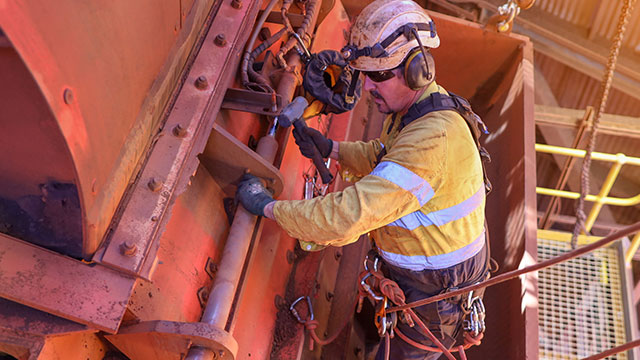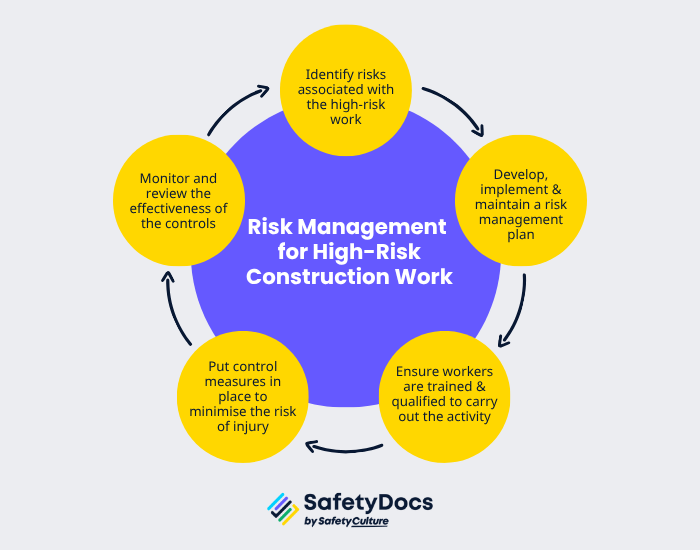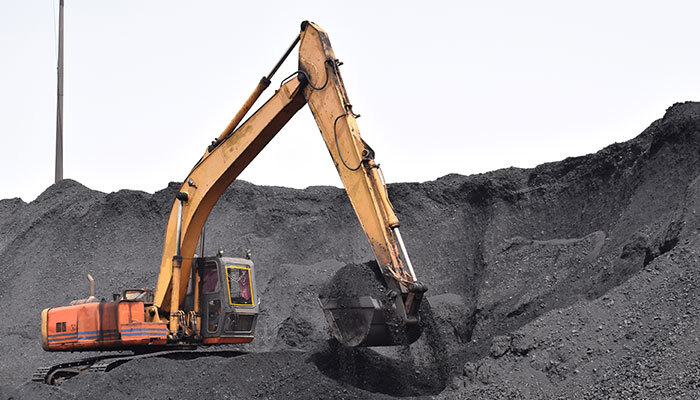Safety is a priority for those involved in construction, considering that construction sites pose one of the highest risks across various industries. To protect workers, Workplace Health and Safety (WHS) laws set out requirements at both state and federal levels. The WHS Regulations identify specific activities as high-risk construction work (HRCW) and require strict risk management processes before these activities can begin.
What is High-Risk Construction Work (HRCW)?
In the construction industry, 18 activities are classified as high-risk construction work due to their great potential for serious injuries and death. Each of these activities requires the use of Safe Work Method Statements (SWMS).
The 18 activities defined as HRCW include the following (in no particular order):
- Work that involves a risk of a person falling more than two metres
- Work on a telecommunication tower
- Demolition of an element of a structure that is load-bearing or otherwise related to the physical integrity of the structure
- Work that involves, or is likely to involve, the disturbance of asbestos
- Structural alterations or repairs that require temporary support to prevent collapse
- Work in or near a confined space
- Work in or near a shaft or trench with an excavated depth greater than 1.5 metres or in or near a tunnel
- Work with the use of explosives
- Work on or near pressurised gas distribution mains or piping
- Work on or near chemical, fuel or refrigerant lines
- Work on or near energised electrical installations or services
- Work in an area that may have a contaminated or flammable atmosphere
- Work involving tilt-up or precast concrete
- Work on, in, or adjacent to a road, railway, shipping lane or other traffic corridors that are in use by traffic other than pedestrians
- Work in areas in which there is the movement of powered mobile plant
- Work in areas in which there are artificial extremes of temperature
- Work in or near water or other liquid that involves a risk of drowning
- Work that involves diving

The Value of Identifying HRCW
Understanding the list of defined high-risk construction work (HRCW) is crucial in managing risk because:
Compliance: The HRCW list provides a clear and comprehensive understanding of the construction work considered high-risk and therefore subject to additional controls and regulations. This helps to ensure compliance with the WHS regulations and reduces the risk of legal penalties.
Risk Assessment: Employers and workers can specifically identify and assess the risks associated with construction activities, such as working at heights or excavations, and implement effective control measures to mitigate those risks.
Injury Prevention: The identification and management of the risks associated with HRCW helps to reduce the likelihood of serious injury or death in the workplace, promoting the health and safety of workers in the construction industry.
By understanding the importance of controlling risks associated with HRCW, employers and workers can contribute to the development of a positive safety culture on site.
Implementing Risk Management for HRCW
As mentioned, risk management is an essential component of managing HRCW, and the process starts by identifying the list of hazards on site. The WHS Regulation requires a Person Conducting a Business or Undertaking (PCBU) to:
- Identify risks associated with high-risk construction work.
- Develop, implement, and maintain a risk management plan.
- Ensure that workers are trained and qualified to carry out the activity.
- Put control measures in place to eliminate or minimise the risk of injury.
- Monitor and review the effectiveness of the controls.

Risk Control Measures
When controlling certain risks, duty holders are also required by the WHS Regulation to follow the hierarchy of control measures. This framework ranks control measures from excellent protection and dependability to those that provide the least positive control. From the highest level of control the hierarchy is as follows:
1. Eliminate the risk
This involves the removal of the danger or the dangerous working practice from the place of employment. This is the control measure that will have the most impact. For example, carrying out the task while standing on the ground eliminates the possibility of falling from a height.
2. Minimise the risk by substitution
This entails that the hazard is substituted with a less hazardous one. For example, replacing an ordinary brick-cutting saw blade with a noise-reduced saw blade will minimise the risk of exposure to hazardous noise.
3. Minimise the risk by isolation
This involves isolating the hazard from people who may be exposed to it. For example, providing barriers between workers and power lines can minimise the risk of electric shock.
4. Minimise the risk by engineering controls
This requires introducing preventive measures that provide a physical or mechanical barrier between the worker and danger. Such efforts include installing guard rails around an elevated work area or using air filtration systems to reduce airborne contaminants.
5. Minimise the risk by administrative controls
Administrative controls may be considered when other higher-order control measures cannot be implemented or when further safety must be ensured. These include creating policies, implementing written safe work procedures, or providing training to reduce risks.
6. Minimise the risk by using personal protective equipment (PPE)
PPE, or personal protective equipment, is a control measure of the lowest tier in the hierarchy of control measures. PPE should only be considered if the other higher-order control methods have been exhausted or if additional security against the danger is required.
Combining control measures
Controlling risk requires careful consideration and a combination of control methods in many situations. While introducing new risks may be an unavoidable consequence of adding or changing control measures, carefully observing the combined control measures' effectiveness is necessary to ensure any new risks are managed appropriately. It will also help to identify any additional risks that may have been previously overlooked, making the overall risk management process more comprehensive and proactive.
Safe Work Method Statements (SWMS) for HRCW
Safe Work Method Statements (SWMS) are documents that should be prepared before any HRCW commences in Australia. The SWMS must adhere to the WHS Regulations and provide all necessary information about control measures to protect everyone involved.
All hazards and risks associated with the activity must be identified, addressed, and controlled within the SWMS. Furthermore, it should outline precisely how these processes will be implemented safely. It is also essential that any changes resulting from additional safety requirements are updated accordingly to ensure each job site remains safe at all times.
Examples of SWMS for High-Risk Construction Work:
- Asbestos Licensed Removal Safe Work Method Statement: Removing friable or non-friable asbestos that requires a licence requires a SWMS. This statement discusses the risks and controls involved.
- Height Access Equipment Safe Work Method Statement: This SWMS ensures worker safety. The guide explains what to do before and during work at height. It's also about how you arrange your job, what tools you use, and how you interact with other employees.
- Overhead Electric Lines - Working Near Safe Work Method Statement: A Safe Work Method Statement must be followed when working near power lines. This SWMS discusses the dangers and necessary preventative measures, as well as the actions of mobile plants and vehicles in such circumstances.
- Roof Edge Protection Safe Work Method Statement: This SWMS outlines the potential dangers and preventative measures that should be taken when doing roof edge work.
- Suspended Powered Scaffolds Working On Safe Work Method Statement: This SWMS addresses the risks and preventative measures connected to suspended scaffolding systems.
- Bulk Excavations Safe Work Method Statement: This SWMS addresses bulk excavation earthworks dangers and controls. It provides construction regulations for mobile plant mobility, refuelling and electrical hazards.

FAQs: High-Risk Construction Work in Australia
Do I need a SWMS for every high-risk task?
Yes. Every activity listed as high risk in the WHS Regulations requires a SWMS before work starts. This ensures the risks are identified, documented, and controlled before any work begins, which protects both workers and the business from avoidable hazards.
Who is responsible for preparing the SWMS?
The PCBU is responsible, but it should be developed with input from the workers and contractors who will be doing the job. Involving those on the tools helps make the SWMS more accurate, practical, and relevant to the actual site conditions.
Can I use one SWMS across multiple sites?
Only if the hazards and controls are identical. Otherwise, it must be adapted to suit each site. Even small differences in layout, weather conditions, or equipment can change the risks and make an unmodified SWMS unsafe or non-compliant.
What happens if we start work without a SWMS?
It’s a breach of WHS law, can lead to serious penalties, and increases the risk of injury or death. Regulators take this seriously, and failure to have a SWMS in place can also damage your company’s reputation and relationships with clients.
When should a SWMS be reviewed?
Whenever work changes, new hazards are identified, or after an incident. Routine reviews also help maintain accuracy, ensuring that the document reflects the real conditions on site and remains effective in protecting workers.
Is PPE enough to manage high-risk work?
No. PPE should be used alongside other controls and only after higher-level measures have been considered. Relying solely on PPE leaves workers exposed if the equipment fails or is used incorrectly, so it should never be the first or only line of defence.
Where can I find ready-to-use SWMS and other safety documents?
SafetyDocs by SafetyCulture offers a comprehensive range of up-to-date safety documents including SWMS, SOPs, Construction Management Plans, and Emergency Plans designed to ensure effective construction risk control and compliance with Australian safety standards.
Manage High-Risk Construction Work Using SafetyDocs
If you're looking for safety documents related to HRCW, SafetyDocs by SafetyCulture can help. We are Australia's leading WHS document provider of health and safety documentation, offering an extensive range that is up-to-date with the latest industry standards and regulations.
Browse our full range of WHS documents for HRCW compliance, including ready-to-use SWMS, SOPs, and emergency plans. With our customisable solutions, you can create a tailored safety document library that meets your organisation's unique needs.
Safe Work Method Statements (SWMS)
SWMS are required whenever there is HRCW. Here are some SWMS you can use for the corresponding HRCW:
- Asbestos Licensed Removal SWMS
- Height Access Equipment SWMS
- Working Near Overhead Electric Lines SWMS
- Roof Edge Protection SWMS
- Working On Suspended Powered Scaffolds SWMS
- Bulk Excavations SWMS
Safe Operating Procedures (SOP)
Safe Operating Procedures (SOPs) for construction work aim to keep people safe and ensure the successful completion of projects. They outline setup, management, and project completion with safety in mind. Additionally, SOPs may discuss emergency protocols in case of an accident or injury.
An example of some SafetyDocs SOPs can be seen here:
- Manual Handling Safe Operating Procedure
- Cherry Picker Safe Operating Procedure
- Backhoe Loader Safe Operating Procedure
Construction Management System
Management Systems are essential for high-risk construction work. They allow duty holders and workers to monitor and control safety risks to ensure onsite performance. This includes hazard identification, risk assessment, and implementation of control measures.
We have the following Management System that are designed to keep duty holders and workers safe:
Construction Management Plans
Construction Management Plans are designed to ensure any construction project's safety and successful completion. They outline the responsibilities of all parties involved, such as the contractor, subcontractors, suppliers, and other stakeholders. They also provide a detailed description of how the project should be carried out, step-by-step instructions on materials needed, and timelines for each stage.
Here are some of our Construction Management Plans:
Emergency Plans
In an accident or injury, it is essential to have a strategy for responding quickly and effectively. An emergency plan should include protocols for ensuring safety, evacuating the site, dealing with medical injuries, and contacting authorities when necessary. Additionally, an emergency plan will help ensure that everyone involved understands their responsibilities during a crisis.
Check out the following emergency plans for your construction site:
You can rely on SafetyDocs by SafetyCulture to ensure that all of your employees are safe and fully compliant with their legal obligations. Contact us today and make sure your workplace is running safely and efficiently.
Available for instant download and supplied in fully editable MS Word format for use in your business.
Please note that the above information is provided as a comment only and should not be relied on as professional, legal or financial advice.
Share This Article
